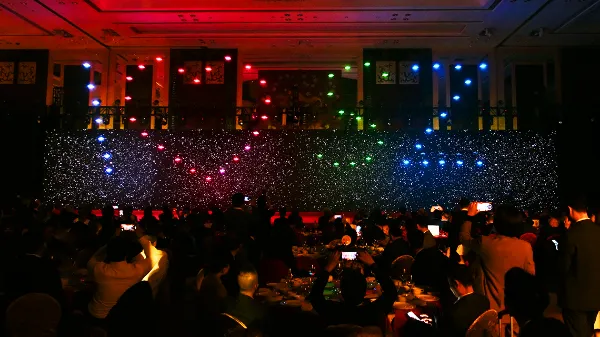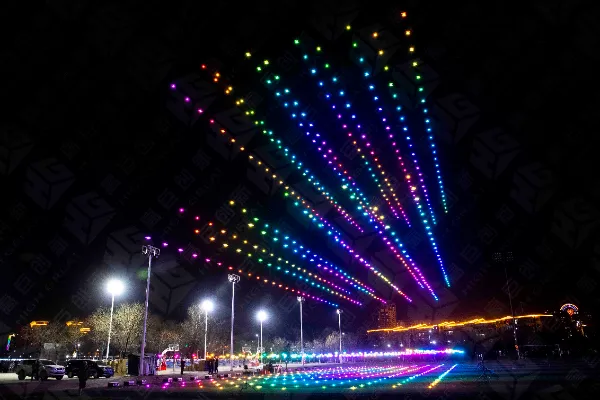The difference between creating indoor and outdoor drone light show
Drone light shows have become increasingly popular in recent years, captivating audiences with their stunning aerial displays of light and color. These shows are not only visually impressive but also offer a unique and innovative way to showcase events, celebrations, and special occasions. However, creating a drone light show is not as simple as just flying a few drones in the air and turning on some lights. There are several technical and creative aspects to consider, especially when it comes to creating indoor and outdoor drone light shows. In this blog post, HighGreat will explore the differences between creating indoor and outdoor drone light shows, and the technical and creative aspects involved in each.
Indoor Drone Light Shows
Indoor drone light shows are typically performed in large indoor spaces such as arenas, stadiums, and convention centers. These shows offer a unique way to enhance the atmosphere of an event, create a memorable experience for attendees, and showcase a brand or product. However, creating an indoor drone light show comes with its own set of challenges and considerations.
Technical Aspects
One of the main technical considerations when creating an indoor drone light show is the size and layout of the venue. Indoor spaces are often more confined than outdoor spaces, which means that there is less room for the drones to maneuver. This can make it more challenging to create complex formations and patterns, and may require more precise programming and choreography.
Another technical consideration is the lighting and sound systems in the venue. Indoor drone light shows rely heavily on lighting and sound effects to create a captivating experience for the audience. Therefore, it is important to ensure that the lighting and sound systems are compatible with the drone light show and can be synchronized with the drones' movements.
Creative Aspects
When it comes to the creative aspects of an indoor drone light show, the possibilities are endless. Indoor spaces offer a unique canvas for creating immersive and interactive experiences for the audience. For example, drones can be programmed to fly through tunnels, create 3D shapes, and interact with performers on stage.
One of the key creative considerations for an indoor drone light show is the theme or message that the show is trying to convey. The theme should be reflected in the choreography, lighting, and sound effects of the show, and should be designed to create an emotional connection with the audience.

Outdoor Drone Light Shows
Outdoor drone light shows are typically performed in open spaces such as parks, stadiums, and city centers. These shows offer a unique way to celebrate special occasions, such as New Year's Eve, Independence Day, and other cultural events. However, creating an outdoor drone light show comes with its own set of challenges and considerations.
Technical Aspects
One of the main technical considerations when creating an outdoor drone light show is the weather conditions. Outdoor drone light shows are often performed at night, which means that the drones are exposed to the elements, such as wind, rain, and snow. Therefore, it is important to ensure that the drones are equipped with the necessary sensors and technology to navigate through different weather conditions.
Another technical consideration is the size and layout of the outdoor space. Outdoor spaces are often much larger than indoor spaces, which means that there is more room for the drones to maneuver. This can make it easier to create complex formations and patterns, but may also require more drones to be used in the show.
Creative Aspects
When it comes to the creative aspects of an outdoor drone light show, the possibilities are also endless. Outdoor spaces offer a unique canvas for creating immersive and interactive experiences for the audience. For example, drones can be programmed to fly in formation to create shapes and patterns in the sky, or to interact with fireworks displays.
One of the key creative considerations for an outdoor drone light show is the environment in which the show is taking place. The show should be designed to complement the natural surroundings and create a sense of awe and wonder for the audience. For example, a drone light show in a city center may incorporate iconic landmarks and buildings into the choreography, while a show in a park may incorporate natural elements such as trees and water features.

Conclusion
In conclusion, creating a drone light show is a complex and challenging process that requires careful consideration of both technical and creative aspects. When it comes to creating indoor and outdoor drone light shows, there are several differences and considerations to keep in mind. Indoor drone light shows require more precise programming and choreography due to the confined space, while outdoor drone light shows require more drones and consideration of weather conditions. However, both indoor and outdoor drone light shows offer a unique and innovative way to showcase events, celebrations, and special occasions, and can create a memorable experience for audiences.

 Telephone No.Email
Telephone No.EmailMailbox number:marketing@hg-fly.com



